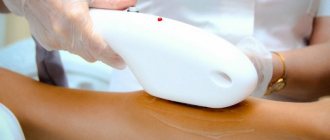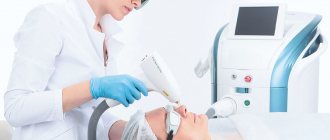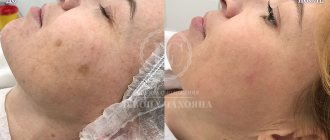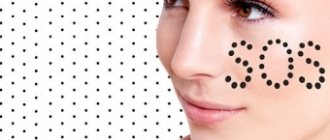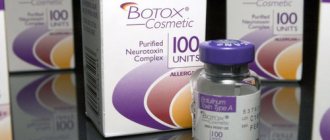Author
: Grachev Ilya Illarionovich
Editor
: Efremov Mikhail Mikhailovich
Publication date: 03/18/2019 Update date: 11/12/2020
- Drug therapy
Eczema on the legs can manifest itself in different ways, it all depends on its type and the cause of its development. This disease develops against the background of hereditary predisposition and the influence of a complex of external and internal factors. It is always problematic to accurately establish all the causes of a disease, but it still needs to be done, since eliminating the causes is the basis of successful treatment. They are excellent at treating eczema at the Moscow Paramita clinic.
Why does eczema develop on the lower extremities?
It is now known for sure that heredity plays a large role in the development of this disease, that is, the peculiarities of the body’s response to certain external and internal factors. These are certain deviations in metabolism, the functioning of the nervous and endocrine systems. All this leads to the fact that the immune system gives an inadequately high (allergic) reaction to certain external and internal influences.
External factors that provoke the development of eczema on the legs include:
- any long-term skin diseases; especially often the cause is fungus of the fingers and toes;
- increased sweating of the feet and wearing tight shoes;
- frequent superficial injuries of the legs (abrasions, cracks, wounds), especially the knees (for example, in football players);
- long-term irritation of the skin of the feet upon contact with various substances (lime, builders’ paints, etc.);
- constant hypothermia or overheating of the legs;
- alcohol abuse, frequent smoking - contributes to persistent narrowing of peripheral blood vessels and disruption of metabolic processes in the skin;
- insect bites.
Internal factors include:
- peripheral circulatory disorders; in women this is more often associated with varicose veins, in men – with obliterating endarteritis;
- chronic diseases of the digestive system - gastritis, enterocolitis, pancreatitis, cholecystitis;
- chronic foci of infection in the body - tonsillitis, sinusitis, carious teeth, etc.;
- allergic diseases;
- endocrine diseases and hormonal disorders.
Eczema of any localization can spread throughout the body, so do not delay treatment.
See how easily the disease can be cured in 10-12 sessions.
Spots in men
The reasons that contribute to the appearance of red spots on the head of the penis in men may or may not be related to infection. Non-infectious factors include a reaction to a condom, insufficient hygiene, and sensitivity to personal hygiene items. Infectious factors may be suspected in the case of unprotected sexual intercourse, frequent changes of partners, and reduced immunity. A doctor can correctly distinguish between conditions and, accordingly, determine methods of treatment. Therefore, if a rash occurs, you should not hesitate to contact a venereologist or dermatologist.
Stages of progression and first symptoms of eczema on the legs
Typical manifestations of acute eczema on the legs or exacerbation of its chronic course are a series of successive stages of weeping eczema:
- Redness of the skin in the form of a small spot, turning into a papule (raising above the skin).
- Bubbles (vesicles) with transparent contents form on the surface of the papules.
- The blisters burst, the affected surface becomes wet, as serous wells form in place of the blisters, through which inflammatory fluid flows onto the surface.
- The liquid dries, forming crusts; At the same time, new bubbles appear, which immediately burst, become wet and create a motley picture of the affected skin.
- Gradually, the inflammation goes away, the crusts fall off, and discolored or dark spots form in their place. Over time they also pass.
Red spots on the skin after stress
Diagnosis of skin diseases
With the next exacerbation, all stages are repeated, but the longer the disease lasts, the less pronounced its symptoms are. Depending on the cause of development, there are three main types of eczema: true, microbial and occupational.
Red papules and plaques on the skin
A number of diseases are characterized by red formations:
- pityriasis rosea (represented by many small scaly spots of a pinkish tint, which are located around one large, so-called “mother” plaque);
- lichen planus (the etiology of this disease is not clear, lichen is represented by red-pink nodules that shine and itch);
- dermatitis herpetiformis (the rash appears suddenly, is characterized by severe itching and has the appearance of vesicles, papules or blisters);
- secondary syphilis (in the case of syphilis, specific tests will be positive);
- drug toxicoderma (occurs due to the use of certain medications and chemicals that cause a specific reaction in patients in the form of allergies);
- granuloma fungoides, or mycosis fungoides (similar to eczema, develops gradually and causes severe itching);
- psoriasis - plaques in this chronic disease have a red-pink appearance (they are covered with white scales, which in turn peel off easily);
- chronic itchy dermatosis (a widespread or limited area of the affected area, a rash of non-infectious origin, characterized by hardening and thickening of the skin).
True eczema on the legs
True eczema can manifest itself in the form of the typical step-by-step weeping rash described above. The most common localization of rashes is the skin in the area of the knees and legs. Exacerbations of the disease are associated with stress, hypothermia and diet disorders. Often this process is accompanied by an infection, which leads to the appearance of pus, yellow crusts, increased weeping, and prolonged exacerbation.
Dyshidrotic and callous form
This form of the disease develops in the area of the soles of the feet. The skin here is rough, so the disease in this area manifests itself somewhat differently and is called dyshidrotic. Externally, flat bubbles with transparent contents with a diameter of about 5 mm can be seen on the soles. Skin redness is slight. Bubbles may undergo the following changes:
- merge with each other, forming large “lakes”;
- rupture with the formation of erosions and ulcers;
- dry to form dense crusts.
Gradually increasing, the lesion can spread to the dorsum of the foot, where the course takes on a typical step-by-step character. The chronic course of the dyshidrotic form causes increased keratinization of the skin with the formation of rough skin growths on it - dry eczema.
Localization of red spots on the body: on the back, chest, palms
The localization and description of red spots is of great importance in diagnosis. If they appear on the back and chest after taking medications or allergenic products, it is most likely an allergy (you can find effective ointments for allergies here). Also, spots in this location can be early symptoms of infectious diseases such as meningitis, chicken pox, rubella and others. The location of red spots on the palms has its own etiological factors:
- contact dermatitis - due to the use of detergents, cosmetics, and less often products;
- infectious diseases;
- non-allergic dermatitis – sensitivity to cold;
- hormonal pathology – diabetes (treated by an endocrinologist);
- neurological factor – vegetative-vascular dystonia, stress.
Microbial eczema on the legs
Microbial eczema is caused by various skin lesions and skin infections. Characterized by secondary eczematization of bacterial and fungal skin lesions. Of the bacterial lesions, streptococcal infections that develop on the skin in the area of wounds, abrasions and trophic ulcers most often undergo such transformations.
In the foot area, the cause of eczematization is often fungal infections, so some experts distinguish fungal eczema separately. It lasts for a long time, sometimes after eliminating the fungal infection it turns into its true form. There are several forms of microbial eczema on the legs.
Basic principles of treatment
Treatment should be long-term and complex. Since the causes and treatment of eczema on the legs are interrelated, first of all they try to identify and eliminate all factors contributing to the development of the disease. Complex therapy includes:
- diet, healthy lifestyle;
- drug therapy that eliminates the symptoms of the disease;
- non-drug treatment methods that have a general healing effect on the body.
Drug therapy
When eczema on the legs worsens, dermatologists often begin treatment by prescribing medications that eliminate unpleasant symptoms. But experts are well aware that this is not a solution: many medications that suppress inflammation and allergies, and relieve itching, have significant side effects. Thus, the most effective drugs of this series - ointments and creams with glucocorticosteroid hormones (GCS) cause:
- rapid addiction with fading of the therapeutic effect;
- decreased local immunity and increased infection;
- tendency to chronicize the acute process.
Therefore, all products for external (ointments, creams, sprays) and internal (tablets) use are prescribed, as a rule, in short courses, with an emphasis on non-drug treatment methods.
Treatment of eczema on the legs without creams, ointments and tablets
To avoid relapses, it is necessary to eliminate the cause of the disease.
Read more about our unique method of treating eczema
Non-drug methods of treating eczema on the legs are now preferred all over the world, since these methods are aimed at activating the body’s own defenses and suppressing the processes underlying allergic reactions. Modern Western and traditional Eastern treatments include:
- Physiotherapeutic procedures: infrared heating – restores normal blood circulation in the skin, eliminates inflammation;
- electrosleep – restores the normal relationship between sleep and wakefulness, eliminates the effects of stress.
- acupuncture - the impact of needles on special points on the body (acupuncture points - AT), reflexively associated with individual organs and tissues;
Features of white spots on the skin with vitiligo
The formation of milky white or pink areas can occur in any area of the skin.
The predominant localization is the area of the arms, face, as well as the inguinal folds and elbow bend. There was no development of depigmentation on the palms or soles. The localized version of the disease is associated with the appearance of spots on limited areas of the body. The most pronounced vitiligo is after sunbathing, since against the background of healthy skin the area turns out noticeably paler. The progression of the disease is accompanied by an increase in spots more than 10 cm in diameter. In some cases, a rim with pronounced pigmentation may appear.
The main characteristics of the formations include:
- edges (they are smooth), lesions can grow and merge;
- shape - most often it is oval or irregular;
- the relief is usually smooth and unchanged;
- the surface is clean: without peeling and rashes of various types.
Pronounced changes are accompanied by loss of pigment over almost the entire area of the skin, which can be confused with albinism. In this case, there is no loss of sensitivity. When the area is localized on the scalp, a change in hair shade is observed. The disease is not life-threatening. The main problem it poses is due to a violation of the patient’s adaptation to society, which is caused by appearance features.
How to treat foot eczema at the Paramita Clinic
The Moscow Paramita Clinic specializes in the treatment of chronic skin diseases. The clinic's dermatologists use a complex of individually selected European and Oriental techniques. They have undergone appropriate training in the world's best centers and successfully apply their knowledge and skills in practice. The courses of treatment can quickly eliminate acute manifestations of the disease and prevent relapses without any side effects. Clinic patients suffering from eczema regularly undergo anti-relapse courses of therapy to completely eliminate all manifestations of the disease.
Eczema on the legs is not a death sentence. With the right lifestyle and regular anti-relapse treatment, you can forget about its existence. Only the doctor decides how to treat eczema on the legs in one case or another.
Sign up for a free initial appointment
Who to contact for skin diseases
If there are no serious reasons for concern, and you observe individual skin imperfections, consult a cosmetologist. If you have any symptoms characteristic of skin diseases - redness, rash, spots, you should consult a dermatologist. The specialist will quickly determine the cause of the disease and prescribe effective treatment.
If necessary, you will be referred for consultation to other specialists - an allergist, dermatovenerologist, endocrinologist or gastroenterologist. Perhaps the problem requires only cosmetic treatment. If drug treatment is required, do not be afraid. Of course, you will need patience and compliance with all the instructions of your doctor. In addition to drug therapy, modern dermatology also uses psychotherapeutic techniques, physiotherapeutic and hardware procedures, and sanatorium-resort treatment has a positive effect.
Prevention of foot eczema
For prevention in persons with a family history (close relatives are ill), it is worth following a number of rules. The same rules should be followed to prevent relapses of an existing disease:
- stop smoking and drinking alcohol;
- avoid stress and heavy workloads;
- get enough sleep, move more;
- watch your diet - eat mostly hypoallergenic foods;
- treat chronic diseases and foci of infection in a timely manner;
- wear shoes that do not squeeze your feet;
- wash your feet daily in warm water and soap, wipe dry and apply hypoallergenic cream to the skin;
- get rid of contact with allergens and hypothermia.
Causes and symptoms
Changes in skin pigmentation can be associated with both excessive melanin production and its deficiency.
The first violation includes the appearance of:
- Age spots (nevi). This type of disorder may indicate internal diseases. So, spots near the mouth indicate problems with
- stomach.
- Birthmarks and moles. They can be present from birth and be hereditary. New ones appear due to hormonal changes in the body.
- Freckles (ephelids). The reason for their appearance is the uneven distribution of tyrosine (melanin is synthesized from it) under the influence of sunlight.
- Chloasma - symmetrical beige spots on the face and other parts of the body. They may appear during pregnancy due to incorrect operation
- liver and ovaries, when infected with helminths.
- Melanomas are tumors containing melanin.
Due to an insufficient amount of melanin, the following can be diagnosed:
- Albinism (lack of pigment in skin, hair, eyes).
- Vitiligo (white spots on affected areas). The reason is improper functioning of the immune system.
- Both vitiligo and albinism are hereditary.
- The color of the skin is affected by dermatitis, fungus, and lichen. The skin also changes color at the site of a burn, bite, or injection. Pigmentation is disrupted due to problems with the immune system, due to the effects of hormonal and other drugs.



